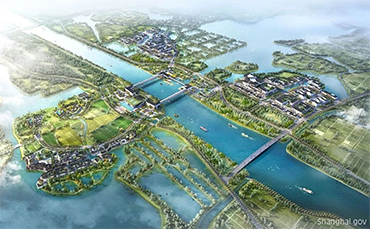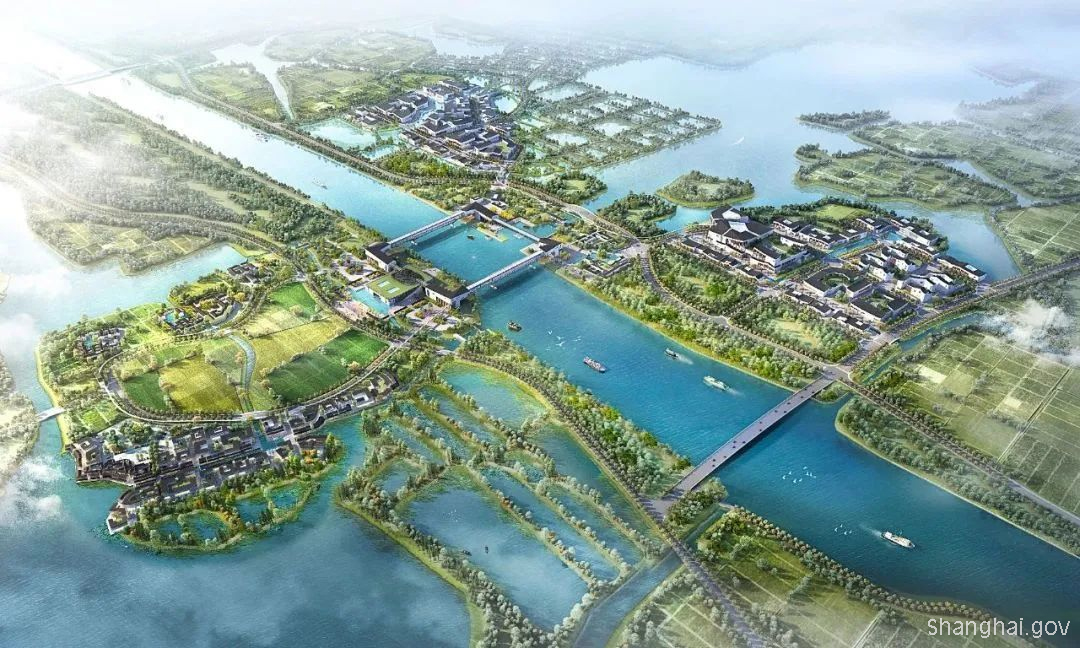



▲ Aerial overview of the “One destination and one core" spatial structure of the “Water Town Parlor” in the Yangtze River Delta. [Shanghai.gov]
The Detailed Territorial Planning of the “Water Town Parlor” in the Yangtze River Delta Ecological Green Integrated Development Demonstration Area was jointly released by the Executive Committee of the Demonstration Area and the people's government of the relevant two districts and county.
As the first cross-provincial detailed territorial planning in China, the Detailed Territorial Planning of the “Water Town Parlor” consists of 13 chapters and 45 sections, including 42 planning maps and detailed planning codes. According to the plan, development positioning, target and vision, spatial layout, industrial development, public service, transportation system, ecological environment, etc. are introduced, which can be divided into the following three aspects.
1. Background of the Planning.
1.1 Planning area.
The “Water Town Parlor” is centered around the geodetic datum of the Yangtze River Delta, comprising partial areas of Jinze Town in Qingpu District of Shanghai Municipality, Lili Town in Wujiang District of Suzhou City in Jiangsu Province, and Xitang Town and Yaozhuang Town in Jiashan County of Jiaxing City in Zhejiang Province. The total area is approximately 35.8 square kilometers.
1.2 Functional positioning.
The “Water Town Parlor” is a demonstration area that showcases the achievements of integrated development in the Yangtze River Delta. It is a functional model area that embodies the ecological green concepts jointly created by two provinces and one city. It serves as a practice and demonstration of the development concept of harmonious coexistence between city and water, mutual vitality, and sharing of regions. And it is an experimental field for institutional innovation in extensive consultation, joint contribution, co-participation, shared benefits, and win-win strategy in the Yangtze River Delta.
1.3 Development targets.
The total area of urban and rural buildable land is 838.32 hectares. Additionally, 2 hectares of flexible buildable land are reserved in each of the three regions, with a development density controlled within 25%. By 2025, comprehensive interconnection and integration of the three regions will be fully developed, the ecological system and transportation network will be established, municipal infrastructure construction will be promoted, the key functional nodes will be built step by step, and the blue ring water system will be formed. By 2035, the “Water Town Parlor” will be fully developed as a world-class demonstration area that integrates production, residence, culture, and ecology and it will become a paradigm and core for high-quality integrated development across administrative regions.
2. Spatial Structure and Planning Strategy.
2.1 Spatial Structure.
The “Water Town Parlor” establishes a spatial structure of “one destination, one core, three parks, three zones, three ways, and many villages”, shaping a new Jiangnan style with a blend of Jiangnan charm, small-town character, and modern style, with blue-green space accounting for about 75%.
“One destination” refers to the square hall and water courtyard, which promotes regional integrated development. It aims to fully explore the unique value of the geodetic datum of the Yangtze River Delta and create a distinctive functional place that is perceivable and experiential and fosters a sense of integrated identity.
“One core” refers to the core area of the “Lounge” near the geodetic datum of the Yangtze River Delta, which includes three major clusters of the innovation engine, a science and technology park, and an exhibition village. It serves the vital role of the “Lounge” and lay out diverse innovative settlement spaces.
“Three parks” refers to the Jiangnan Polder, Mulberry Dyke Fish Pond, and Water Town Wetland theme display parks. With lakes and polders as the base, the parks integrate the modern green ecological concepts and technologies with the long-standing traditional water management culture, utilizing techniques such as wetland purification, water conservation, recycling agriculture, polder reconstruction, and so on to form an integration of blue and green space and ecological system, and finally create a world-class lake landscape.
“Three zones” refers to the three major functional areas namely Jinze, Fenhu, and Dashun. The zones incorporate innovative settlements and integrate regional functional projects of innovation services, cultural creativity, scientific research and development, and ecological experience through a combination of stock transformation and new construction, presenting future-oriented production and living scenes.
“Three ways” refers to the blue way, greenway, and scenic way, which link the water town’s scenic areas through water and land transportation. These ways connect natural geography with cultural landscapes and create a “beautiful Jiangnan region like a natural gallery” as the construction goal of the blue ring in the “Water Town Lounge”.
“Many villages” refers to the science and technology village, innovation village, and cultural tourism village. Promoting rural revitalization through delivering the strategies such as functional enhancement, scene improvement, and selective renewal to active the stock buildable land in villages, and creating water towns with the integration of production, residence, and ecology.
Source:
<https://www.shanghai.gov.cn/nw12344/20230531/2482f044b21b4e729c041db948367184.html>
<https://mp.weixin.qq.com/s/gmnmTYtHup0dXyYs30M3MQ>
Edited and Translated by Guo Xinxin